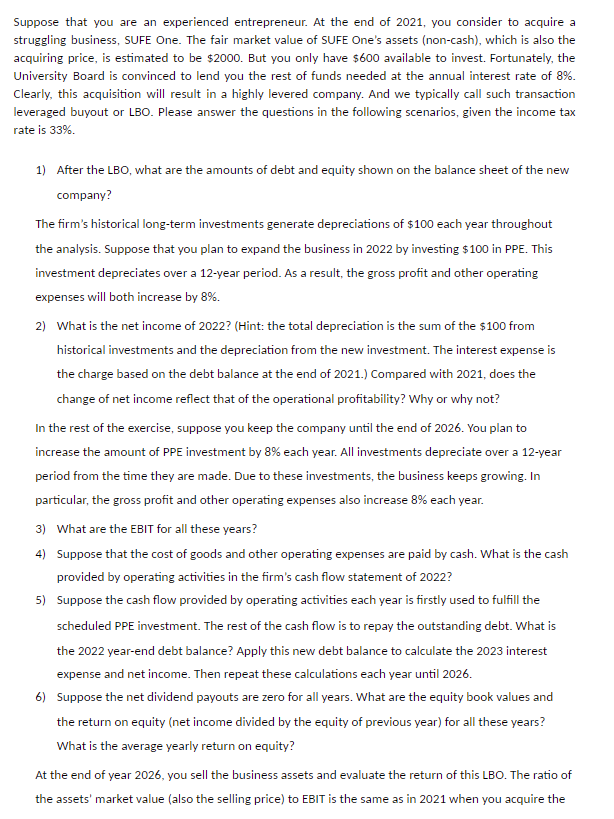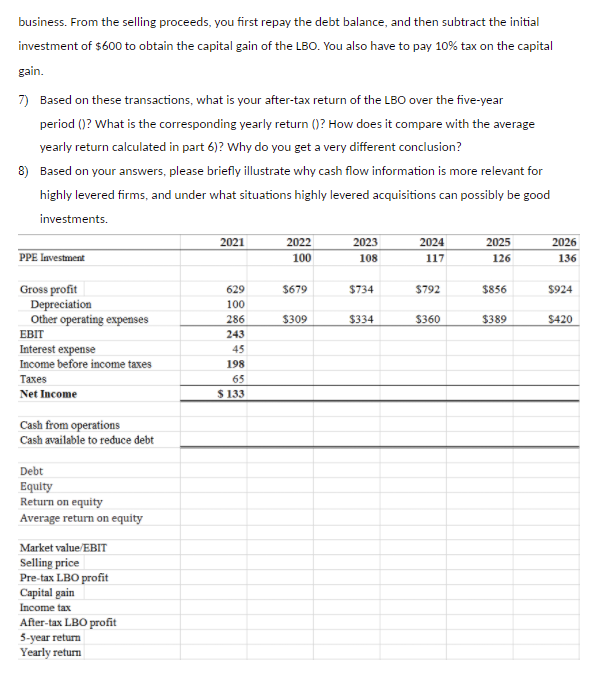Answered step by step
Verified Expert Solution
Question
1 Approved Answer
Suppose that you are an experienced entrepreneur. At the end of 2021, you consider to acquire a struggling business, SUFE One. The fair market value


Suppose that you are an experienced entrepreneur. At the end of 2021, you consider to acquire a struggling business, SUFE One. The fair market value of SUFE One's assets (non-cash), which is also the acquiring price, is estimated to be $2000. But you only have $600 available to invest. Fortunately, the University Board is convinced to lend you the rest of funds needed at the annual interest rate of 8%. Clearly, this acquisition will result in a highly levered company. And we typically call such transaction leveraged buyout or LBO. Please answer the questions in the following scenarios, given the income tax rate is 33% 1) After the LBO, what are the amounts of debt and equity shown on the balance sheet of the new company? The firm's historical long-term investments generate depreciations of $100 each year throughout the analysis. Suppose that you plan to expand the business in 2022 by investing $100 in PPE. This investment depreciates over a 12-year period. As a result, the gross profit and other operating expenses will both increase by 8%. 2) What is the net income of 2022? (Hint: the total depreciation is the sum of the $100 from historical investments and the depreciation from the new investment. The interest expense is the charge based on the debt balance at the end of 2021.) Compared with 2021, does the change of net income reflect that of the operational profitability? Why or why not? In the rest of the exercise, suppose you keep the company until the end of 2026. You plan to increase the amount of PPE investment by 8% each year. All investments depreciate over a 12-year period from the time they are made. Due to these investments, the business keeps growing. In particular, the gross profit and other operating expenses also increase 8% each year. 3) What are the EBIT for all these years? 4) Suppose that the cost of goods and other operating expenses are paid by cash. What is the cash provided by operating activities in the firm's cash flow statement of 2022? 5) Suppose the cash flow provided by operating activities each year is firstly used to fulfill the scheduled PPE investment. The rest of the cash flow is to repay the outstanding debt. What is the 2022 year-end debt balance? Apply this new debt balance to calculate the 2023 interest expense and net income. Then repeat these calculations each year until 2026. 6) Suppose the net dividend payouts are zero for all years. What are the equity book values and the return on equity (net income divided by the equity of previous year) for all these years? What is the average yearly return on equity? At the end of year 2026, you sell the business assets and evaluate the return of this LBO. The ratio of the assets' market value (also the selling price) to EBIT is the same as in 2021 when you acquire the business. From the selling proceeds, you first repay the debt balance, and then subtract the initial investment of $600 to obtain the capital gain of the LBO. You also have to pay 10% tax on the capital gain. 7) Based on these transactions, what is your after-tax return of the LBO over the five-year period (? What is the corresponding yearly return (? How does it compare with the average yearly return calculated in part 6)? Why do you get a very different conclusion? 8) Based on your answers, please briefly illustrate why cash flow information is more relevant for highly levered firms, and under what situations highly levered acquisitions can possibly be good investments. 2021 2022 100 PPE lavestment 2023 108 2024 117 2025 126 2026 136 $679 $734 $792 $856 $924 $309 $334 $360 $389 $420 Gross profit Depreciation Other operating expenses EBIT Interest expense Income before income taxes Taxes Net Income 629 100 286 243 45 198 65 $ 133 Cash from operations Cash available to reduce debt Debt Equity Return on equity Average return on equity Market value/EBIT Selling price Pre-tax LBO profit Capital gain Income tax After-tax LBO profit 5-year return Yearly return Suppose that you are an experienced entrepreneur. At the end of 2021, you consider to acquire a struggling business, SUFE One. The fair market value of SUFE One's assets (non-cash), which is also the acquiring price, is estimated to be $2000. But you only have $600 available to invest. Fortunately, the University Board is convinced to lend you the rest of funds needed at the annual interest rate of 8%. Clearly, this acquisition will result in a highly levered company. And we typically call such transaction leveraged buyout or LBO. Please answer the questions in the following scenarios, given the income tax rate is 33% 1) After the LBO, what are the amounts of debt and equity shown on the balance sheet of the new company? The firm's historical long-term investments generate depreciations of $100 each year throughout the analysis. Suppose that you plan to expand the business in 2022 by investing $100 in PPE. This investment depreciates over a 12-year period. As a result, the gross profit and other operating expenses will both increase by 8%. 2) What is the net income of 2022? (Hint: the total depreciation is the sum of the $100 from historical investments and the depreciation from the new investment. The interest expense is the charge based on the debt balance at the end of 2021.) Compared with 2021, does the change of net income reflect that of the operational profitability? Why or why not? In the rest of the exercise, suppose you keep the company until the end of 2026. You plan to increase the amount of PPE investment by 8% each year. All investments depreciate over a 12-year period from the time they are made. Due to these investments, the business keeps growing. In particular, the gross profit and other operating expenses also increase 8% each year. 3) What are the EBIT for all these years? 4) Suppose that the cost of goods and other operating expenses are paid by cash. What is the cash provided by operating activities in the firm's cash flow statement of 2022? 5) Suppose the cash flow provided by operating activities each year is firstly used to fulfill the scheduled PPE investment. The rest of the cash flow is to repay the outstanding debt. What is the 2022 year-end debt balance? Apply this new debt balance to calculate the 2023 interest expense and net income. Then repeat these calculations each year until 2026. 6) Suppose the net dividend payouts are zero for all years. What are the equity book values and the return on equity (net income divided by the equity of previous year) for all these years? What is the average yearly return on equity? At the end of year 2026, you sell the business assets and evaluate the return of this LBO. The ratio of the assets' market value (also the selling price) to EBIT is the same as in 2021 when you acquire the business. From the selling proceeds, you first repay the debt balance, and then subtract the initial investment of $600 to obtain the capital gain of the LBO. You also have to pay 10% tax on the capital gain. 7) Based on these transactions, what is your after-tax return of the LBO over the five-year period (? What is the corresponding yearly return (? How does it compare with the average yearly return calculated in part 6)? Why do you get a very different conclusion? 8) Based on your answers, please briefly illustrate why cash flow information is more relevant for highly levered firms, and under what situations highly levered acquisitions can possibly be good investments. 2021 2022 100 PPE lavestment 2023 108 2024 117 2025 126 2026 136 $679 $734 $792 $856 $924 $309 $334 $360 $389 $420 Gross profit Depreciation Other operating expenses EBIT Interest expense Income before income taxes Taxes Net Income 629 100 286 243 45 198 65 $ 133 Cash from operations Cash available to reduce debt Debt Equity Return on equity Average return on equity Market value/EBIT Selling price Pre-tax LBO profit Capital gain Income tax After-tax LBO profit 5-year return Yearly return
Step by Step Solution
There are 3 Steps involved in it
Step: 1

Get Instant Access to Expert-Tailored Solutions
See step-by-step solutions with expert insights and AI powered tools for academic success
Step: 2

Step: 3

Ace Your Homework with AI
Get the answers you need in no time with our AI-driven, step-by-step assistance
Get Started


